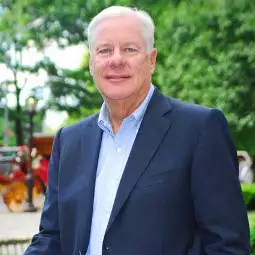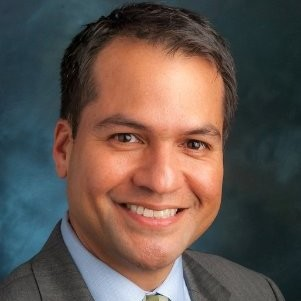
Image courtesy:Image provided by authors of the article featuring Larry Wilson
An interview by Lee Fogle and Adon Navarette
What’s it like to join a Unicorn before Wall Street knew what a unicorn was? A startup, a new tech launch, an insurance technology company that lived up to the early hype and that kept its promises, met market expectations and EPS forecasts for investors consistently for two decades? It was eighteen years of life lived in dog years for me, extremely hard work, constant global travel, often bitter disappointments but big victories that moved the needle. The one person in the company who knew more about insurance, more about technology and more about this new business of applications software was the founder and CEO, Larry Wilson. For years he has been referred to as the father of insurance software due to the explosion of software providers that came from his companies in the decade that followed.
I’m Lee Fogle and I joined Policy Management Systems Corporation (PMSC) in 1983, two years after the initial public offering. For a young twenty something year old I couldn't have scripted a better place to learn and grow in my career— living through business case studies real time, nonstop as we encountered the myriad of challenges in an emerging global industry and we grew and blazed trails that had never been tread upon. . . .
- In the 1970’s Larry Wilson, the founder and the first entrepreneur of an insurance technology company, was the first to design, build, sell and implement a full insurance business processing system: underwriting, rating, claims, and billing all integrated
- When I joined the company in 1983 we had about 500 employees and were close to 50 million in revenue
- At our high water mark we were about $800 million with 6,000 employees with operations and customers in 30 countries
- At one point 70% of the insurance industry ran their business on one of the PMSC systems.
- The culture was fun, focused and everything happened extremely fast. Everyone was incentivized and compensated by our continual balance of three groups we served: Customers, Investors and Employees
- The culture, focus, vision, energy and the long-term consistent success originated in the founder, CEO, chief architect, chief visionary, race car driver, and avid offshore angler: Larry Wilson
I worked for Larry for 18 years and learned so much about taking care of customers, living up to commitments even if we lost money on a project, vertical strategy, and being a visionary leader. For the thousands who knew him as our CEO his contribution fueled many of us to go out and start our own companies or to run companies for others. It’s said that over 300 new companies globally have been founded by people who had been at PMSC.
Adon Navarette and I caught up with Larry at his true “startup garage” in South Florida. A veritable museum where he has 85 cars on display that’s he personally managed the restoration of each one-of-a-kind classic, antique as well as some more recent race cars. Many of the museum pieces Larry has actually raced. From this garage he also runs his Tech investments, serves on multiple boards, advises several Private Equity and Venture Capital funds, and founds and assists new startups, and other investments in Insurtech. He has never taken a break from his industry since the early 1970s.
Larry began his career at Seibels, a South Carolina insurance company, when he was a 19-year-old student at USC. He found out that he could take IBM classes for free, so he went to each one that was offered. He also earned his Chartered Property Casualty Underwriter (CPCU) designation. This background in computers and insurance turned into a well-timed growth opportunity for Larry — and for Columbia.
“I decided I wanted to develop software for the insurance industry. There were very few people who understood both software and insurance,” Larry says. He took full advantage of his unique perspective and position, turning PMSC into a technology powerhouse. Larry served as its CEO from its incorporation in 1981 until it was merged with CSC in 2000.
“We started with five people, and at one time, we were hiring 25 people per week,” Larry remembers. “We ended up doing business with 70 percent of all insurance companies in the world. We did business in 30 countries.” When PMSC was sold to CSC, it had 6,000 employees.
Larry later joined FirstMark Capital, a $1.8 billion early stage venture capital fund, and flew his small plane up and back weekly for ten years to his New York office from his home in Columbia. During those ten years in his spare time he actually started four new and successful technology companies and was a major investor in two others.
Among the Columbia-based companies are DoveTail, which has grown every year and is located on Columbia’s Main Street; Eagle Eye Analytics on Taylor Street; and Duck Creek, which was sold to Accenture first with Larry’s oversight, and then control has sold to APAX, with Larry’s assistance.
The truly impressive thing is that despite his longevity, Wilson continues to innovate. He is a board member, advisor and investor in Duck Creek and several other businesses at the leading edge of insurance technology.
(Adon & Lee) We recently sat down with Larry and asked him about the future of Insurance Technology.
(Larry) “In terms of where technology is going in the insurance industry, I think it is certainly going to cloud technology. There is no need of having a data center with a lot of capital tied up on the balance sheet. It becomes obsolete very quickly and there are issues with security, availability, staying current, and costs. The cloud is far more efficient, it’s secure and there are fewer depreciating assets on the balance sheet. You pay for what you use and you get as much capacity as you need. It’s secure and available. So I think the days of insurance companies having data centers are numbered” Larry explained.
(Adon & Lee) What do you think is going to change?
(Larry) “The first thing that is going to change is the infrastructure of insurance companies. I suspect it will be several waves that will take some time before it’s completely done. As I said we are starting to see an increasing wave of cloud computing. The second thing I see happening is that software should be easily configurable to how your business is being operated. If you want to go into a new state, introduce a new product, change pricing methodology, claims handling processes, or any other business process, these changes should be easily configurable. The software you are using should enable your company to configure how you can best operate your business and use the best business practices depending on you distribution system preferences, the economics of your business, your customer desires, and what you have to achieve to get sustainable and appropriate economic returns. So configurable software and cloud computing are continuing to be the two biggest active trends in property and casualty insurance technology innovation.
(Adon & Lee) Talk about AI and the impact it’s having on the Insurance industry.
(Larry) “AI and machine learning are going to be another fast-growing component of technology and insurance. The insurance industry’s linear actuarial science models have been based on using Generalized Linear Models (GLM). However, the relationship of the variables that correlate to an outcome are variable and are not linear. When you look at what correlates the claims cost for example, you might find 4 or 5 attributes that have high correlation and you will see different new relationships depending on the unique risk characteristic. It is these nonlinear relationships of the variables that insurers can discover that is very important in effective pricing risks. For example, we found with AI the variables that correlate to apartment building claims in NY are not many of the ISO based data (distance to fire station, quality of fire station, etc,). What does highly correlate to low loss ratios is: does it have surface parking, doormen, elevator access, and secure HVAC units. The difference in the loss ratio using AI-based pricing was dramatically more accurate and the knowledge created a large advantage for competitively pricing the best risks and avoiding the underpriced risks. AI will change actuarial science to be nonlinear and will not using predetermined variables. The variables will be defined based on how they correlate to the outcomes. Some will be trivial and some will have great impact.
The other thing that I think is important is the insurance business models are going change. The business models have become too complex, too cumbersome and too expensive. My belief is that the ultimate business model was three hundred years ago at Lloyds Coffee House. A merchant who was going to send cargo by ship from London to Capetown could go to Lloyd’s and obtain insurance. At Lloyds the merchant would be able to find experienced underwriters specializing in the route and the cargo and understanding who the ship’s captain was, the ship's name, the value of the cargo, the route they would be taking and the time of year of the voyage. The underwriter, considering the unique needs of the Marchant, would provide a price quotation and then, if agreed they would write the policy and the sale was complete.
The key was that the underwriter understood the merchant’s need and developed a policy to fit their need. If the ship sank they knew the value of the cargo and they rang the bell, wrote them a check and then the customer came down to Lloyds coffee house had a cup of coffee and got the check. What an efficient business model. Only the customer and the underwriter would be involved. The needs were understood and they were met with the best available price and coverage.
Over the past 300 years things have gotten very complex, with many people involved with each carrying out very specialized tasks, some of which could be done with machine learning and artificial intelligence analyzing the data. It comes down to understanding the three basic questions that must be answered to provide insurance:
- which risks to write,
- what price to charge, and
- when there is a claim how much to pay.
That’s what property and casualty insurance is all about. And while there is a great need for specialization and detailed specific knowledge on different types of products and needs, the degree of complexity is far too great. Its needs to be simplified and it will take technology people that understand insurance to be able to be sure when the technology is appropriate and to be able to use human judgment where appropriate.
There is not going to be a machine that can always give you the answer, but rather there is going to be some business judgement involved. The broker, the underwriter, the claims professional and all the people that work with them that provide specialized services will be operating as a digital based ecosystem. The complexity of the ecosystem needs to be made simpler and be fully digital to reach a basic level of requirements in the future. Fully digital means all third parties that are in the ecosystem: medical providers, auto repair, rental car agencies, appraisers, homebuilder’s, repairmen, replacement dealers, and retailers, etc, must be digital interfaces.
Virtually every industry has some presence in the insurance supply chain. it cannot be done by people that only understand technology, that will not work. It’s been tried a few times and we have seen a fair share of project disappointments in the industry over the last 40 years from people that didn’t understand insurance. People that do not understand technology but do understand insurance is equally limiting. The real value is going to be created by people that understand both.”
(Adon & Lee) You are also a CEO of an insurance company, what do you ask technology to do for your company?
(Larry) “I think the first thing is how to I get greater precision and accuracy in pricing. It’s been done by a lot of techniques in the past that were linear based methods that are not very accurate. Moving to nonlinear is a great opportunity to improve pricing. Another viewpoint must answer the question is the risk being priced fairly. Are there excess expenses? In some insurance products today the expenses are 40 cents of every dollar of premium, sometimes the expense ratio for the carrier can be 30% including commission and acquisition cost, and then the claim settlement cost can be 10 percent or more of the premium.
If close to 40 cents out of every dollar is going to expenses and only 60 cents of every dollar is going to the claimant and underwriting profit this creates a lot of opportunity for highly efficient digital based distributors to win market share. How do we get overhead down to single digits?
I remember when stock prices in the 80s and 90s were quoted in bid and ask with a $.25 spread. Today its .001 of 1 percent. You look at stock prices trending in the last 20 years and the incredible decrease in the cost of stock trades are down to fractions of a penny versus 25 cents. In insurance I don’t see any dramatic changes in pricing. You see some isolated areas in the commercial lines business. There is more competition in auto insurance, of course, because it’s highly advertised and big carriers can scale and lower acquisition costs. But there is still too much friction. It’s a very complex system requiring change to come from forward thinking leaders that understand insurance and technology. Apple is not going to change it. Amazon may. Amazon could be the biggest threat to some of the insurance industry incumbents if they set up their own digital insurance operation”.
(Adon & Lee) We waere trained by you and there are few people that ever looked at a premium dollar like we do. And it’s the simplest way, you just simply draw a picture of a pie chart and say here is where the money goes. Let's focus on where we can make an impact.
(Larry) “The real key is simplifying the business model. Some companies have been able to adopt a very efficient digital model that have very low expense ratios and very high value. I think there’s more opportunity to do that. We will see more insurance carriers being created to cater to a certain sector of the market that they understand better than anyone else.
I am the chairman of a digital based insurance company that we formed 4 yrs. ago. We write commercial catastrophe exposed property insurance along the Gulf and Atlantic coasts. What we’ve learned is that hurricanes are very predictable over the long term. You cannot predict when they are going to happen but in a 40-year period you can predict how many will occur. If you take South Carolina for example, in our lifetime there are only 2 category 1 hurricanes: Hurricane Hazel in 1954 and Hugo in 1989. You don't know if the next Hugo is going to come in the beginning of the summer or the next year or in 10 years from now, but it is going to happen. It’s the same thing that happened in Miami with Andrew in 1992 and the same thing with Katrina in New Orleans. If you insure all along the Gulf Coast and the Atlantic and spread your risks then it becomes very predictable. Over a 40 year period you can get very good returns, and you are going to have some catastrophes,, but that’s okay as long as you spread the risks and you understand the construction requirements and all the loss prevention opportunities. The keys are being able to price risks based on what has been done to prevent and mitigate the risks and then the spread of risks because unpreventable claims are going to happen, and finally be very efficient using modern cloud based systems that are configurable and using AI and machine learning, and advanced modeling to select and price risks based managed repair services were appropriate for claims.”
(Adon & Lee): you’ve seen and done so much in your career so far, what words of encouragement, admonition, or guidance would you offer as a parting word for the vast sea of Insurtech companies out there?
(Larry) "Don’t be a solution in search of a problem. Instead,
- hire great people and connect them to the right metrics that objectively measure their effectiveness and success.
- Be a learning organization where everyone knows the importance of and the problems in insurance.
- Focus on solving the hardest problems in insurance using elegant and simple technology solutions
- Make your solution a game-changer for your customers.




